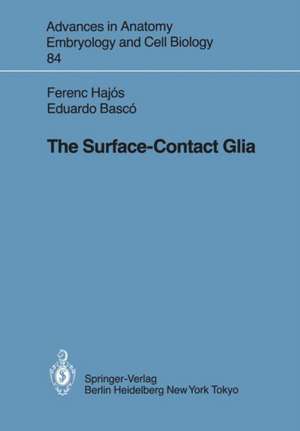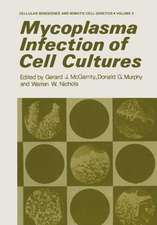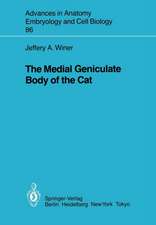The Surface-Contact Glia: Advances in Anatomy, Embryology and Cell Biology, cartea 84
Autor F. Hajos, E. Bascoen Limba Engleză Paperback – mai 1984
Din seria Advances in Anatomy, Embryology and Cell Biology
- 5%
 Preț: 1146.33 lei
Preț: 1146.33 lei - 5%
 Preț: 721.19 lei
Preț: 721.19 lei - 15%
 Preț: 637.13 lei
Preț: 637.13 lei -
 Preț: 381.81 lei
Preț: 381.81 lei - 15%
 Preț: 644.95 lei
Preț: 644.95 lei - 5%
 Preț: 1025.16 lei
Preț: 1025.16 lei - 15%
 Preț: 689.97 lei
Preț: 689.97 lei - 15%
 Preț: 577.07 lei
Preț: 577.07 lei - 15%
 Preț: 580.36 lei
Preț: 580.36 lei - 5%
 Preț: 393.51 lei
Preț: 393.51 lei -
 Preț: 408.66 lei
Preț: 408.66 lei -
![Die Schlüpfdrüse der Geburtshelferkröte (Alytes o. obstetricans [LAURENTI]) und anderer Froschlurche](https://i4.books-express.ro/bs/9783662239742/die-schluepfdruese-der-geburtshelferkroete-alytes-o-obstetricans-laurenti-und-anderer-froschlurche.jpg) Preț: 408.27 lei
Preț: 408.27 lei - 5%
 Preț: 1090.61 lei
Preț: 1090.61 lei - 5%
 Preț: 705.11 lei
Preț: 705.11 lei - 5%
 Preț: 706.04 lei
Preț: 706.04 lei - 5%
 Preț: 357.61 lei
Preț: 357.61 lei - 5%
 Preț: 704.59 lei
Preț: 704.59 lei - 5%
 Preț: 705.11 lei
Preț: 705.11 lei - 5%
 Preț: 359.42 lei
Preț: 359.42 lei - 5%
 Preț: 711.52 lei
Preț: 711.52 lei - 15%
 Preț: 635.47 lei
Preț: 635.47 lei - 15%
 Preț: 631.72 lei
Preț: 631.72 lei - 15%
 Preț: 633.35 lei
Preț: 633.35 lei - 15%
 Preț: 632.37 lei
Preț: 632.37 lei - 5%
 Preț: 706.60 lei
Preț: 706.60 lei - 15%
 Preț: 631.07 lei
Preț: 631.07 lei - 5%
 Preț: 707.13 lei
Preț: 707.13 lei - 5%
 Preț: 707.33 lei
Preț: 707.33 lei - 5%
 Preț: 359.60 lei
Preț: 359.60 lei - 5%
 Preț: 707.69 lei
Preț: 707.69 lei - 5%
 Preț: 707.13 lei
Preț: 707.13 lei - 5%
 Preț: 708.06 lei
Preț: 708.06 lei - 5%
 Preț: 706.41 lei
Preț: 706.41 lei - 5%
 Preț: 708.78 lei
Preț: 708.78 lei - 5%
 Preț: 705.68 lei
Preț: 705.68 lei - 5%
 Preț: 705.11 lei
Preț: 705.11 lei - 5%
 Preț: 706.77 lei
Preț: 706.77 lei - 15%
 Preț: 635.15 lei
Preț: 635.15 lei - 15%
 Preț: 631.07 lei
Preț: 631.07 lei - 5%
 Preț: 706.77 lei
Preț: 706.77 lei - 5%
 Preț: 706.04 lei
Preț: 706.04 lei - 5%
 Preț: 710.79 lei
Preț: 710.79 lei - 5%
 Preț: 705.32 lei
Preț: 705.32 lei - 15%
 Preț: 633.19 lei
Preț: 633.19 lei - 15%
 Preț: 629.09 lei
Preț: 629.09 lei - 15%
 Preț: 633.53 lei
Preț: 633.53 lei - 15%
 Preț: 632.70 lei
Preț: 632.70 lei - 15%
 Preț: 633.68 lei
Preț: 633.68 lei - 18%
 Preț: 773.72 lei
Preț: 773.72 lei - 15%
 Preț: 630.43 lei
Preț: 630.43 lei
Preț: 358.32 lei
Preț vechi: 377.18 lei
-5% Nou
Puncte Express: 537
Preț estimativ în valută:
68.60€ • 71.57$ • 57.50£
68.60€ • 71.57$ • 57.50£
Carte tipărită la comandă
Livrare economică 13-27 martie
Preluare comenzi: 021 569.72.76
Specificații
ISBN-13: 9783540132431
ISBN-10: 3540132430
Pagini: 92
Ilustrații: VI, 84 p. 18 illus.
Dimensiuni: 170 x 244 x 5 mm
Greutate: 0.16 kg
Editura: Springer Berlin, Heidelberg
Colecția Springer
Seria Advances in Anatomy, Embryology and Cell Biology
Locul publicării:Berlin, Heidelberg, Germany
ISBN-10: 3540132430
Pagini: 92
Ilustrații: VI, 84 p. 18 illus.
Dimensiuni: 170 x 244 x 5 mm
Greutate: 0.16 kg
Editura: Springer Berlin, Heidelberg
Colecția Springer
Seria Advances in Anatomy, Embryology and Cell Biology
Locul publicării:Berlin, Heidelberg, Germany
Public țintă
ResearchCuprins
1 General Introduction.- 1.1 Brief History.- 1.2 Development of the Glia: Current Views and Problems.- 2 Materials and Methods.- 3 Postnatal Cell Proliferation at Nongerminal Sites of the Brain.- 3.1 Introductory Remarks.- 3.2 Mitotic Activity at Nongerminal Sites of the Immature Cerebellar Cortex.- 3.3 Mitotic Activity at Nongerminal Sites of the Immature Forebrain: Time Course and Regional Distribution.- 3.4 Comments.- 3.5 Light and Electron Microscopic Description of [3H] Thymidine-Labeled Cells at Nongerminal Sites of the Postnatal Brain.- 3.6 Comments.- 4 Radial Glia in the Pre- and Postnatal Brain.- 4.1 Introductory Remarks.- 4.2 GFAP Immunocytochemistry of the Developing Forebrain.- 4.3 Silver Impregnation of the Forebrain Radial Glia.- 4.4 Comments.- 5 Demonstration of Proliferative Capacity of the GFAP-Immunoreaetive Radial Glia.- 5.1 Introductory Remarks.- 5.2 [3H]Thymidine Uptake into the GFAP-Immunopositive Radial Glia.- 5.3 Comments.- 6 Transport of Material by Glial Processes.- 6.1 Introductory Remarks.- 6.2 Transport of HRP by the Forebrain Radial Glia and Cerebellar Bergmanu Glia.- 6.3 Comments.- 7 Discussion.- 7.1 Proliferating Cells at Nongerminal Sites in the Early Postnatal Period.- 7.2 Persistence of the Radial Glia.- 7.3 Does Postnatal Glial Proliferation Involve Dormant Stem Cells or the Differentiated Glia?.- 7.4 Derivatives of and Mechanism of Derivation from the Radial Glia.- 7.5 Common Properties of Radial Glial Derivatives.- 8 Concept of the Surface-Contact Glia.- 9 Current Approaches to the Glia and Some Perspectives.- 10 Summary.- 11 References.- 12 Subject Index.








